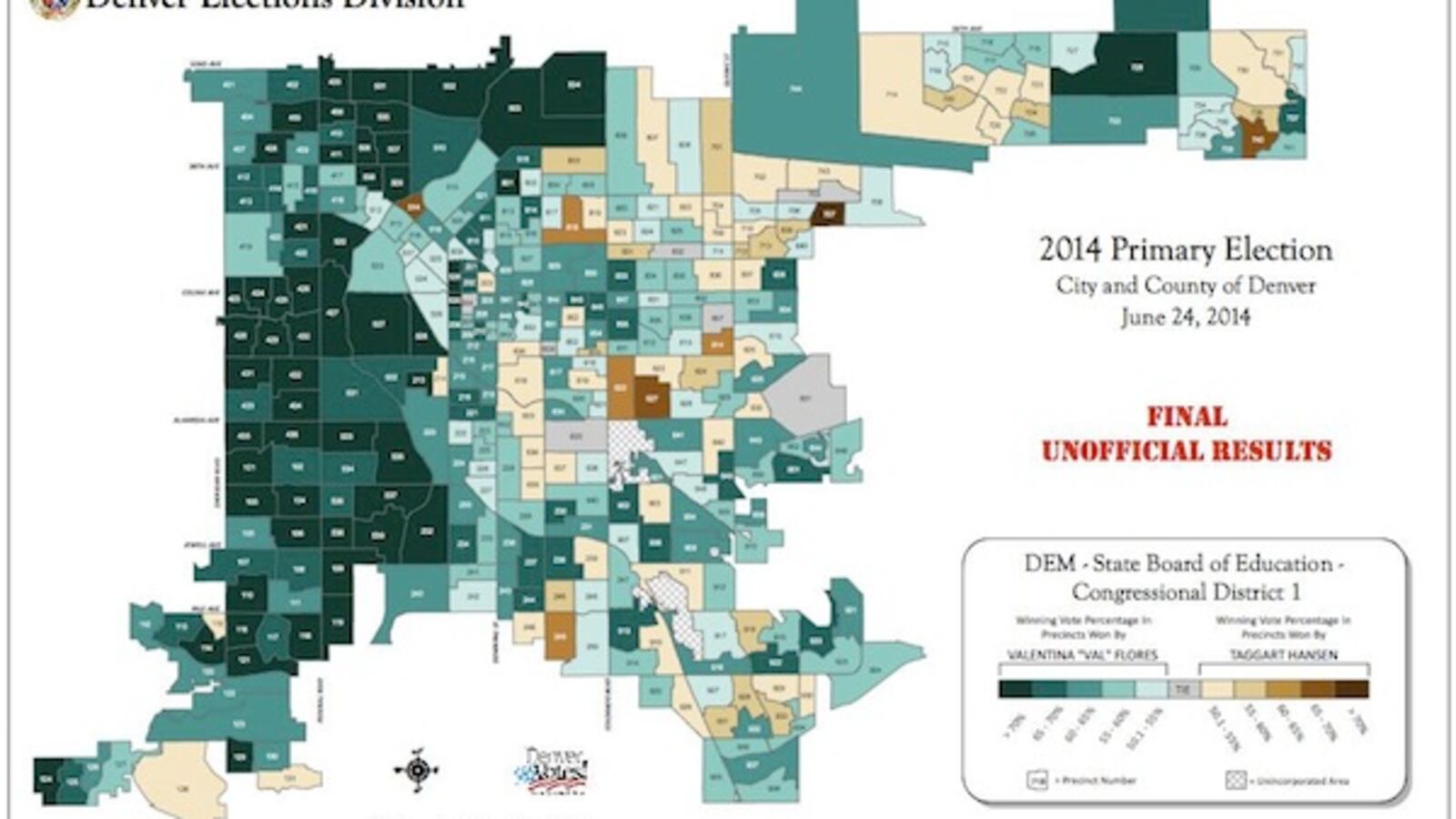Voter turnout, ballot position and hurried, low-visibility campaigns likely were more important than education issues in Val Flores’ victory over Taggart Hansen in the Democratic primary for the 1st District seat on the State Board of Education.
Flores, a retired teacher and professor, won 59 percent of the vote in the race, a surprise to many and a defeat for the coalition of education reform advocacy groups and funders that have been repeatedly successful in a string of Denver Public Schools board races.
The differences in the two campaigns were stark. Flores raised a bit under $20,000 in contributions and non-cash support. Hansen raised more than $35,000 in cash, loans and non-monetary support – and two independent expenditure committees spent more than $100,000 to back him.
But the Flores campaign wiped out the financial advantage, and she swept much of Denver, as the city elections division map above shows. (Greenish shaded precincts were won by Flores; brownish ones by Hansen.) The 1st District also includes a small part of northern Arapahoe County, where Flores also won neatly.
Hansen, a lawyer for CH2M Hill, was backed by reform groups Stand for Children and Democrats for Education Reform, along with some of the same corporate and legal community contributors active in past races for the DPS board. Flores was supported by the Denver Classroom Teachers Association, the Colorado Education Association and the American Federation of Teachers.
The person vacating the seat, Democrat Elaine Gantz Berman, confessed to being “stunned” by the outcome. “I’m deeply disappointed,” said Berman, who publicly backed Hansen.
Flores praised her supporters’ “grassroots campaign” for gaining the victory, and her campaign manager, Dave Sabados, said she won partly because “I don’t think Democrats support the corporate [education reform] agenda.”
Reform-group leaders put a brave face on the race’s outcome and said they don’t think it reflects voter attitudes about education reform policies.
“Denver voters support more innovative ideas for our public education system,” said Sonja Semion, executive director of Stand for Children Colorado. “We don’t often get the full variety of Denver sentiment in a primary election.”
“We were clearly disappointed by the results,” said Jennifer Walmer, state director of Democrats for Education Reform Colorado. “I don’t believe it’s an indictment on reform.”
Stand and DFER both are connected to the independent expenditure committees that support Hansen. Both groups issued statements saying they look forward to working with Flores.
But it may be political realities, not education issues, that led to Tuesday’s result. Here’s a look at some of the factors involved, based on Chalkbeat Colorado research and on comments by people we interviewed.
Concentrated and low turnout
Only 38,033 Democrats voted in the Flores-Hansen race. By contrast, more than 107,000 votes were cast in the 2013 race for an at-large seat on the DPS board, won by former Lt. Gov. Barbara O’Brien, a reform favorite. A key difference is that only Democrats could vote in Tuesday’s election, while any voter regardless of registration can vote in non-partisan DPS races.
So, the lack of GOP and unaffiliated voters may have worked against a “reform” candidate like Hansen.
Low turnout may have been due to the fact that Democrats had no high-profile races – such as the four-way Republican gubernatorial primary – to motivate them to mail their ballots.
“The voters were completely disengaged from the primary. People didn’t have a clue the primary was happening in the Democratic Party,” said Berman. “People didn’t pay any attention to the endorsements,” which included Denver Mayor Michael Hancock, other politicians and the Denver Post editorial page.
Ballot position and name
Because she won a majority of delegates at the Democratic Party nominating assembly, Flores’ name was the first one listed on ballots.
“I think it certainly helps,” said Sabado. Julie Whitacre, a lobbyist for the CEA, said top-line designation usually is a boost for a candidate.
Some sources interviewed by Chalkbeat also said Flores’ Hispanic background may also have helped her. The elections division map shows strong support for her in west Denver, which has concentrations of Hispanic voters.
“The district is heavily Hispanic and minority, and I think they wanted a representative that fit their values,” said one source.
Low-key and short campaigns
Needless to say, members of the State Board aren’t the highest-profile elected officials in Colorado. Lack of voter knowledge makes factors like ballot position more important.
“Nobody really knows what the State Board does and who is running and what the issues are,” said Van Schoales, CEO of A+ Denver, a reform advocacy group.
And, even with significant spending such as that made on Taggart’s behalf, the campaigns had a hard time reaching all potential voters.
In an effort to target voters they considered most valuable, both campaigns tailored mailings and phone calls in some parts of the district and ignored others. Some voters reported receiving as many as a dozen Hansen mailings; Democrats in other parts of the cities received none.
Both campaigns used direct mail, social media and phone calls to make their cases.
Several people interviewed cited the shortness of the campaign as a possible factor in the race. Flores and Hansen were placed on the ballot by a Democratic Party assembly in early April, leaving less than three months to campaign before the primary.
Prior to 2012, the primary election was held in late August, giving candidates a much longer period to reach out to voters.
Schoales called it a “superfast campaign” that didn’t give the candidates much time to get their message to Democratic voters.

